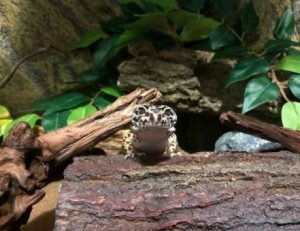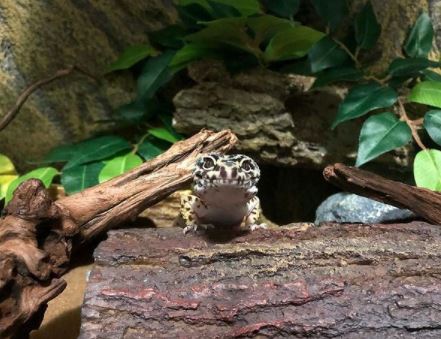Do Leopard Geckos Have Teeth?
Brief Overview of Leopard Geckos as Popular Pets
Do leopard geckos have teeth: Leopard geckos (Eublepharis macularius) have gained significant popularity among reptile enthusiasts and animal lovers alike. Originating from the arid regions of Afghanistan, Pakistan, and northwestern India, these captivating creatures have become one of the most commonly kept reptiles as pets.
Their docile nature, ease of care, and distinct appearance make them an ideal choice for both novice and experienced reptile keepers. Their characteristic features include a stout body covered in unique patterns of spots or “leopard-like” markings hence their name.
Additionally, they possess a muscular tail that aids in storing valuable fat reserves for times when food is scarce. With their impressive ability to adapt to various environmental conditions and relatively simple husbandry requirements, leopard geckos have earned a well-deserved reputation as wonderful companions.
Intriguing Question: Do Leopard Geckos Have Teeth?
 Now let us delve into the fascinating world of leopard gecko dentition. One might ponder if these enchanting creatures possess teeth similar to other animals or if they have evolved some extraordinary mechanism for feeding.
Now let us delve into the fascinating world of leopard gecko dentition. One might ponder if these enchanting creatures possess teeth similar to other animals or if they have evolved some extraordinary mechanism for feeding.
The answer is quite intriguing indeed; leopard geckos do indeed have teeth! However, their dental structures differ from those found in mammals like us humans.
Leopard gecko teeth are part of their reptilian dentition, which has distinct characteristics. Instead of having a single set of teeth like mammals, leopard geckos exhibit polyphyodont dentition.
This means that they continuously replace their teeth throughout their lives. Unlike us with our permanent adult teeth, leopard geckos continually grow and shed teeth as needed.
Understanding the dental anatomy and function of these unique creatures will shed further light on the importance and role of their teeth in capturing, consuming, and digesting prey. Join us as we explore the various types of teeth found in leopard geckos and unlock the marvels of their tooth replacement cycle.
General Dentition in Reptiles
Reptilian dental structures are a fascinating aspect of these ancient creatures’ biology. Unlike mammals, reptiles possess unique dental adaptations that enable them to efficiently capture and consume their prey. The dentition of reptiles is marked by two distinctive characteristics: polyphyodont dentition and heterodont dentition.
Explanation of Reptilian Dental Structures
Reptiles exhibit a diverse range of dental structures tailored to their specific dietary requirements. Their teeth are typically rooted in sockets within the jaws, similar to mammals. However, unlike humans who have only two sets of teeth (baby teeth and permanent teeth), reptiles possess a remarkable ability known as polyphyodont dentition.
Polyphyodont Dentition – Continuous Tooth Replacement
Polyphyodont dentition refers to the continuous replacement of teeth throughout an individual’s lifetime. Unlike humans who only grow one set of permanent teeth, reptiles like leopard geckos constantly regenerate their teeth to maintain optimal functionality.
This process occurs due to the presence of a specialized tissue called the dental lamina. The dental lamina is responsible for producing new generations of teeth as old ones wear down or become damaged.
As the old tooth is shed or lost through normal wear and tear, the underlying dental lamina initiates the growth and development of a replacement tooth. This fascinating phenomenon ensures that leopard geckos, among other reptile species, are never without functional teeth.
Heterodont Dentition – Different Types of Teeth for Specific Functions
Reptiles exhibit heterodont dentition, which means they possess different types of specialized teeth within their jaws that serve distinct functions during feeding. Leopard geckos exemplify this dental adaptation with three main types: incisors, canine-like teeth, and molar-like teeth. Incisors are found at the front of the mouth and are used for grasping and tearing prey items.
These teeth are typically sharp and located in the upper and lower jaws, enabling leopard geckos to capture their prey with precision. Canine-like teeth, on the other hand, are specialized for puncturing the exoskeleton of their prey.
Positioned behind the incisors, these teeth aid in immobilizing the prey during feeding. Molar-like teeth are located toward the rear of the mouth and are adapted for crushing and grinding food items before swallowing.
Reptilian dental structures offer a glimpse into incredible adaptations that have evolved over millions of years. Polyphyodont dentition ensures a continuous supply of functional teeth in leopard geckos through tooth replacement facilitated by the dental lamina.
Heterodont dentition allows these reptiles to possess different types of teeth specialized for various feeding functions such as grasping, puncturing, immobilizing, crushing, and grinding their prey. Understanding these aspects provides valuable insights into the unique oral biology of leopard geckos and other reptilian species.
Leopard Gecko Dental Anatomy
Description of Leopard Gecko’s Oral Cavity and Jaw Structure
The oral cavity of a leopard gecko is a marvel of evolutionary adaptation. Within their intricate mouth structure, leopard geckos possess a well-developed set of jaws that allow for efficient chewing and processing of their prey.
The upper and lower jaws are interconnected through movable joints, offering flexibility and precision in capturing and consuming food. These adaptations enable the leopard gecko to grasp, tear, puncture, crush, and grind its prey effectively.
Upper and Lower Jaws with Movable Joints for Efficient Chewing
The upper jaw (maxilla) in leopard geckos is made up of two separate bones connected by a flexible joint called the cranioquadrate joint. This joint allows the maxilla to move independently from the rest of the skull, granting considerable mobility during feeding.
This flexibility enables the leopard gecko to open its mouth wide to accommodate larger prey items while maintaining stability during biting actions. Similarly, the lower jaw (mandible) consists of two distinct bones joined together by an elastic hinge known as the mandibular symphysis.
This hinge-like connection permits coordinated movements between both parts of the mandible. When feeding, these movable joints contribute significantly to the leopard gecko’s ability to position its teeth accurately for different chewing actions.
Tooth Sockets and Dental Laminae for Tooth Regeneration
 Leopard geckos possess specialized structures within their jaws that facilitate tooth regeneration throughout their lives. Tooth sockets hold each individual tooth securely in place within the dental arches.
Leopard geckos possess specialized structures within their jaws that facilitate tooth regeneration throughout their lives. Tooth sockets hold each individual tooth securely in place within the dental arches.
These sockets provide stability during feeding activities while allowing controlled movement when necessary. Notably, within each socket lies a thin layer called dental laminae that serves as an active site for new tooth development.
The dental laminae contain a population of cells called odontogenic cells, responsible for the continuous production of new teeth. As old teeth wear down or fall out, the dental laminae produce replacement teeth to maintain a functional dentition.
The dental anatomy of leopard geckos showcases their remarkable adaptation for effective feeding and tooth regeneration. The upper and lower jaws’ movable joints allow for precise chewing actions, providing flexibility in capturing and processing prey items.
Tooth sockets secure each tooth while dental laminae serve as active sites for ongoing tooth replacement. Understanding the intricacies of leopard gecko dental anatomy sheds light on their unique ability to thrive in their natural environment.
Types of Teeth in Leopard Geckos
Incisors – Used for Grasping and Tearing Prey Items
Leopard geckos possess a set of remarkable incisors that play a vital role in their feeding behavior. These specialized teeth are located at the front of their jaws and are perfectly adapted for grasping and tearing apart prey items.
The incisors appear sharp, slender, and slightly curved, allowing them to effectively pierce the exoskeleton of their prey. Their arrangement consists of four pairs of upper incisors and two pairs of lower incisors, symmetrically positioned within the oral cavity.
Location, Shape, and Arrangement of Incisors in Leopard Geckos
The upper incisors are situated along the inner edges of the upper jaw’s front section. They exhibit a slightly conical shape with a pointed tip, ideal for gripping onto prey. The lower incisors align correspondingly on the inner edges of the lower jaw’s front portion.
Although smaller than their upper counterparts, they share the same shape and function. The positioning of these teeth enables leopard geckos to accurately latch onto their prey without losing grip during feeding.
Importance of Incisors in Capturing and Consuming Food
Incisor teeth are crucial to leopard gecko’s hunting prowess as they aid in capturing and consuming food efficiently. When hunting live insects or small vertebrates such as worms or baby mice, leopard geckos rely on their sharp incisors to secure a firm hold on their prey items.
Once captured, these teeth help tear apart the exoskeleton or flesh into manageable pieces before swallowing them whole or partially chewing them for easier digestion. Without well-developed incisor teeth, leopard geckos would struggle to catch elusive prey or break down food into more manageable portions suited for digestion.

Canine-like Teeth – Specialized for Puncturing Prey’s Exoskeleton
Among the diverse array of teeth in leopard geckos, their canine-like teeth deserve special attention for their unique characteristics and purpose. Positioned just behind the incisors, these sharp, elongated teeth are designed for puncturing the exoskeletons of insects and other small prey. Their shape resembles that of a canine tooth in carnivorous mammals, hence their name.
Unique Characteristics and Positioning of Canine-like Teeth
The canine-like teeth in leopard geckos are sharply pointed with a distinct curvature that optimizes their efficiency when penetrating through tough exoskeletons. These teeth are rooted deeply within the leopard gecko’s jawbone, ensuring stability during hunting activities. Their positioning allows for precise delivery of force to immobilize prey while minimizing the risk of injury to the predator.
Role in Immobilizing Prey During Feeding
Once these specialized teeth pierce through the prey’s exoskeleton, leopard geckos can exert pressure to immobilize it effectively. By gripping onto their prey with their incisors and then deploying their canine-like teeth, they ensure that struggling or escaping becomes near impossible for the captured creature. This immobilization not only makes feeding more manageable but also prevents potential injuries to the leopard gecko during consumption.
Molar-like Teeth – Adapted for Crushing and Grinding Food Items
Leopard geckos possess another set of remarkable dental structures known as molar-like teeth that aid them in breaking down food items through crushing and grinding motions.
Structure, Placement, and Function of Molar-like Teeth
Located towards the back of their jaws, these molar-like teeth possess broader surfaces compared to incisors or canine-like teeth. With a flatter structure resembling molars in other animals, they have evolved to handle the crushing and grinding of prey. Their placement ensures that once the food is immobilized, it can be efficiently processed for digestion.
Significance in the Digestion Process
The molar-like teeth provide an essential function during digestion by breaking down food into smaller, more manageable pieces. This facilitates easier swallowing and aids in exposing a larger surface area for enzymatic action to take place within the digestive tract. The efficient crushing and grinding process initiated by these teeth enable leopard geckos to extract maximum nutritional value from their diet.
By exploring leopard geckos’ dental anatomy, we gain a deeper understanding of their feeding mechanisms. The incisors allow them to grasp and tear prey items swiftly, while the canine-like teeth ensure successful puncturing of exoskeletons.
The molar-like teeth play a crucial role in processing food for optimal digestion. Understanding how these different types of teeth work together paints a comprehensive picture of how these fascinating creatures capture and consume their prey.
Detailed Explanation of the Leopard Gecko Tooth Replacement Cycle
Shedding Old Teeth through Osteoclasts Activity
Leopard geckos have a remarkable ability to continually replace their teeth throughout their lives, thanks to a process known as polyphyodont dentition. This dental phenomenon involves shedding old teeth and replacing them with new ones.
The first step in this tooth replacement cycle is the shedding of old teeth. The process begins when specialized cells called osteoclasts are activated.
Osteoclasts are responsible for breaking down the tissue that anchors the old tooth to the socket, allowing it to loosen and eventually fall out. These cells work by secreting enzymes that break down the connective tissue fibers surrounding the tooth root.
As a result, the old tooth gradually becomes dislodged from its socket. Once it has fully loosened, it is either swallowed or spat out by the leopard gecko.
Formation of New Teeth by Odontoblasts
After an old tooth is shed, another fascinating aspect of leopard gecko dentition comes into play: the formation of new teeth. Once a tooth is lost, specialized cells called odontoblasts initiate the development of a replacement tooth within its respective dental lamina. Dental laminae are specific regions within a leopard gecko’s jaw where new teeth form.
Odontoblasts actively produce dentin, which is a hard mineralized substance that forms most of each new tooth’s structure. As they deposit successive layers of dentin, these cells gradually shape and sculpt the developing tooth within its dental lamina.
Simultaneously, other cells called ameloblasts secrete enamel onto the surface of each developing tooth. This continuous activity ensures that there is always a reservoir of developing teeth within a leopard gecko’s jaw ready to replace any lost or damaged teeth.
As the new tooth matures, it eventually pushes its way upwards, displacing the old tooth’s remnants until it reaches its functional position within the gecko’s dental arch. The tooth replacement cycle in leopard geckos is a fascinating and intricate process.
Osteoclasts initiate the shedding of old teeth by breaking down the connective tissue that anchors them, allowing them to fall out. Once a tooth is lost, odontoblasts take over and begin constructing a new tooth within a dental lamina using dentin and enamel.
This continuous cycle ensures that leopard geckos always have a fresh set of teeth available for efficient prey capture and consumption. Understanding this process sheds light on the remarkable adaptability of these reptiles’ dental structures.
Dental Health Care for Leopard Geckos
Tips on Maintaining
Proper dental health care is crucial for maintaining the well-being of your leopard gecko. By implementing a few simple measures, you can ensure that your pet’s teeth remain healthy and functional.
Firstly, it is essential to provide a well-balanced diet consisting of appropriate prey items to promote natural tooth wear. This includes offering appropriately sized insects such as crickets or mealworms, which require chewing and tearing.
Another vital aspect of dental care is ensuring optimal calcium intake. Calcium plays a crucial role in tooth development and maintenance.
You can achieve this by dusting prey items with a calcium supplement powder before feeding them to your leopard gecko. Additionally, providing a shallow dish of calcium powder within the enclosure will enable the gecko to self-regulate its calcium intake.
Regular veterinary check-ups are also essential for monitoring the dental health of your leopard gecko. A qualified reptile veterinarian will have the expertise to identify any potential issues and provide appropriate treatment or advice if needed.
To sum up do leopard geckos have teeth
Leopard geckos do possess teeth that are specifically adapted for their dietary needs. Understanding their dental anatomy and implementing proper dental care measures ensures their overall health and well-being.
By providing appropriate prey size, dusting food with calcium supplements, and scheduling regular veterinary check-ups, you can support optimal dental health in your beloved pet. Maintaining good oral hygiene contributes not only to the physical health but also to the overall happiness of your leopard gecko.
So take pride in being an attentive caregiver who prioritizes their pet’s oral care needs. Your dedication will result in a contented reptilian companion who can enjoy all the delights that life has to offer!


